|
|
|
|
 |
RODENTS: Norway Rats |
|
|
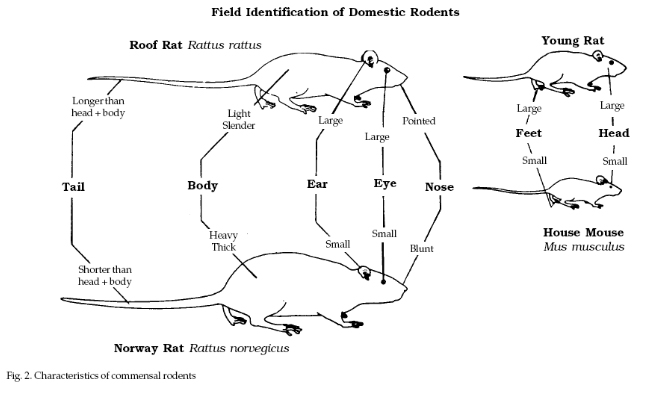
Identification Habitat
The Norway rat (Rattus
norvegicus, Fig. 1) is a stocky burrowing rodent,
unintentionally introduced into North America by
settlers who arrived on ships from Europe. Also called
the brown rat, house rat, barn rat, sewer rat, gray rat,
or wharf rat, it is a slightly larger animal than the
roof rat (Fig. 2). Adult Norway rats weigh an average of
1 pound (454 g). Their fur is coarse and usually
brownish or reddish gray above and whitish gray on the
belly. Blackish individuals occur in some locations.
Range
First introduced into the
United States around 1775, the Norway rat has now spread
throughout the contiguous 48 states. It is generally
found at lower elevations but may occur wherever humans
live.
Habitat
Norway rats live in close
association with people. In urban or suburban areas they
live in and around residences, in cellars, warehouses,
stores, slaughterhouses, docks, and in sewers. On farms
they may inhabit barns, granaries, livestock buildings,
silos, and kennels. They may burrow to make nests under
buildings and other structures, beneath concrete slabs,
along stream banks, around ponds, in garbage dumps, and
at other locations where suitable food, water, and
shelter are present. Although they can climb, Norway
rats tend to inhabit the lower floors of multistory
buildings.
Food Habits
Norway rats will eat
nearly any type of food. When given a choice, they
select a nutritionally balanced diet, choosing fresh,
wholesome items over stale or contaminated foods. They
prefer cereal grains, meats and fish, nuts, and some
types of fruit. Rats require 1/2 to 1 ounce (15 to 30
ml) of water daily when feeding on dry foods but need
less when moist foods are available. Food items in
household garbage offer a fairly balanced diet and also
satisfy their moisture needs.
General Biology, Reproduction, and Behavior
Norway rats are primarily
nocturnal. They usually become active about dusk, when
they begin to seek food and water. Some individuals may
be active during daylight hours when rat populations are
high.
Rats have poor eyesight,
relying more on their hearing and their excellent senses
of smell, taste, and touch. They are considered
color-blind. Therefore, for safety reasons, baits can be
dyed distinctive colors without causing avoidance by
rats, as long as the dye does not have an objectionable
taste or odor.
Rats use their keen sense
of smell to locate food items and to recognize other
rats. Their sense of taste is excellent, and they can
detect some contaminants in their food at levels as low
as 0.5 parts per million.
Norway rats usually
construct nests in below-ground burrows or at ground
level (Fig. 3). Nests may be lined with shredded paper,
cloth, or other fibrous material. Litters of 6 to 12
young are born 21 to 23 days after conception. Newborn
rats are hairless and their eyes are closed, but they
grow rapidly. They can eat solid food at 2 1/2 to 3
weeks. They become completely independent at about 3 to
4 weeks and reach reproductive maturity at 3 months of
age.
Females may come into heat
every 4 or 5 days, and they may mate within a day or two
after a litter is born. Breeding often peaks in spring
and fall, with reproductive activity declining during
the heat of summer and often stopping completely in
winter, depending on habitat. These seasonal trends are
most pronounced in more severe climates. The average
female rat has 4 to 6 litters per year and may
successfully wean 20 or more offspring annually.
Norway rats have physical
capabilities that enable them to gain entry to
structures by gnawing, climbing, jumping, swimming, and
other tactics. For more detailed information on their
physical abilities and the resulting need to design
rodent-proof structures, see the chapter Rodent-Proof
Construction and Exclusion Methods.
Studies indicate that
during its daily activities, a rat normally travels an
area averaging 100 to 150 feet (30 to 45 m) in diameter.
Rats seldom travel farther than 300 feet (100 m) from
their burrows to obtain food or water.
Rats constantly explore
and learn about their environment, memorizing the
locations of pathways, obstacles, food and water,
shelter, and other elements in their domain. They
quickly detect and tend to avoid new objects placed into
a familiar environment. Thus, objects such as traps and
bait stations often are avoided for several days or more
following their initial placement.
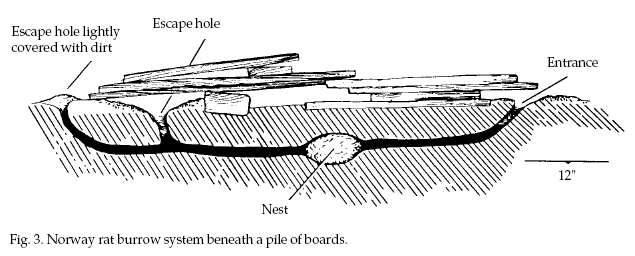
Place baits and bait
stations near, but not on, rat runways. Rats will
quickly find them and after a short period of avoidance,
will cautiously investigate them. Baited but unset traps
will aid in overcoming rats’ fear of them;
expanded-trigger traps set directly on travel routes may
immediately catch rats.
Rats will at first avoid
novel food items placed in their environment. They may
eat very small amounts, and subsequent feeding will
depend on the flavor of the food and its physiological
effect. If the food contains poison or some other
substance that soon produces an ill effect but not
death, the food will often be associated with the
illness. This “bait shyness” was a major problems when
single-dose acute toxicants were the main rodenticides
in use. Today, only two rodenticides registered for
Norway rat control, red squill and zinc phosphide,
possess characteristics that make bait shyness a
potential problem.
Bait shyness can persist
for weeks or months and may be transferred to nontoxic
foods of similar types. Pre-baiting, that is, training
rats to feed repeatedly on nontoxic bait for a period of
days prior to applying the toxicant in the bait, will
largely prevent sublethal doses and thus bait shyness.
It will also lead to successful control, with very few
rats left to become bait-shy. Prebaiting will almost
always increase control success when zinc phosphide or
red squill baits are used.
Because anticoagulant
rodenticides are slow-acting, the rats’ subsequent
illness is not associated with the bait even if a
sublethal dose is consumed; thus, bait shyness does not
usually occur. These baits serve, in effect, as their
own prebait.
Damage and Damage Identification
Norway rats consume and
contaminate foodstuffs and animal feed. They may damage
crops in fields prior to and during harvest, and during
processing and storage. Rats also damage containers and
packaging materials in which foods and feed are stored.
Rats cause structural
damage to buildings by burrowing and gnawing. They
undermine building foundations and slabs, cause settling
in roads and railroad track beds, and damage the banks
of irrigation canals and levees. Rats also may gnaw on
electrical wires or water pipes, either in structures or
below ground. They damage structures further by gnawing
openings through doors, window sills, walls, ceilings,
and floors. Considerable damage to insulated structures
can occur as a result of rat burrowing and nesting in
walls and attics.
Among the diseases rats
may transmit to humans or livestock are murine typhus,
leptospirosis, trichinosis, salmonellosis (food
poisoning), and ratbite fever. Plague is a disease that
can be carried by a variety of rodents, but it is more
commonly associated with roof rats (Rattus rattus) than
with Norway rats.
Rat Sign
The presence of rats can
be determined by a number of signs described below:
Droppings may be found along runways, in
feeding areas, and near shelter. They may be as large as
3/4 inch (2 cm) long and 1/4 inch (0.6 cm) in diameter.
Fresh droppings are soft in texture.
Tracks, including
footprints or tail marks, may be seen on dusty surfaces
or in mud (Fig. 4). A tracking patch made of flour can
be placed in pathways overnight to determine if rodents
are present.
Urine, both wet and dry,
will fluoresce under ultraviolet light. Urine stains may
occur along travelways or in feeding areas.
Runs or burrows may be
found next to walls, along fences, next to buildings, or
under bushes and debris. Rats memorize pathways and use
the same routes habitually.
Smudge marks (rub marks)
may occur on beams, rafters, pipes, and walls as a
result of oil and dirt rubbing off rats’ fur along
frequently traveled routes (Fig. 5).
Gnawing may be visible on
doors, ledges, in corners, in wall material, on stored
materials, or other surfaces wherever rats are present.
Fresh accumulations of wood shavings, insulation, and
other gnawed material indicate active infestations. Size
of entry holes (often 1 1/2 inches [4 cm] in diameter or
less for mice, 2 inches [5 cm] or larger for rats) or
tooth marks can be used to distinguish rat from mouse
gnawing. Rats keep their paired incisor teeth, which
grow continuously at the rate of about 5 inches (13 cm)
per year, worn down by gnawing on hard surfaces and by
working them against each other.
Sounds such as gnawing,
climbing in walls, clawing, various squeaks, and
fighting noises are common where rats are present,
particularly at times of the day when they are most
active.
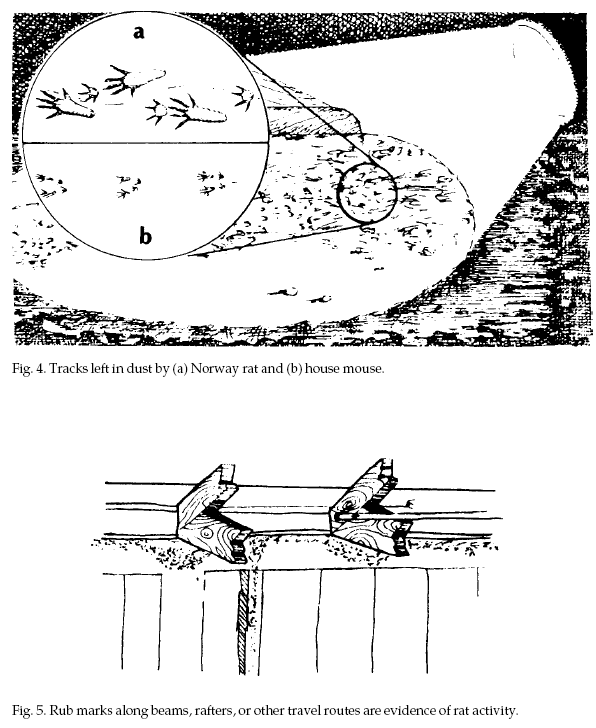
Estimating
Rat Numbers
Rat sign and visual
sightings are of limited value in accurately estimating
rat numbers, but they are the simplest and often the
only practical method available. Search premises
thoroughly when looking for rats. In structures,
searches should include attics, basements, around
foundations, crawl spaces, and behind and under stored
materials. The following estimates can then be made:
No sign: no rats or few
present. If only a few rats are present they may have
invaded only recently.
Old droppings and gnawing
common, one or more rats seen by flashlight at night, or
no rats observed in daytime: medium numbers present.
Fresh droppings, tracks,
and gnawing present, three or more rats seen at night,
or rats seen in daytime: large numbers present.
Since rats are normally
nocturnal and somewhat wary of humans, usually many more
rats are present than will be seen in the daytime. Under
certain conditions, rats may become quite bold in the
presence of humans, and then a high percentage of the
population may be visible.
A conservative estimate of
rat numbers can be made from measuring their food
consumption. You can do this by feeding the rats for a
while on finely ground grain (whole grains or pelleted
foods may be carried off uneaten). When offered over a
period of time, the ground grain will usually be
accepted and eaten by rats. Consumption may gradually
increase to a maximum level over the period of a week or
so as the rats’ natural fear of novel foods is overcome.
Divide the total amount of food eaten per day by 1/2
ounce (15 g); this will give a minimum estimate of the
rats present. Some rats eat more than 1/2 ounce (15 g)
daily, but rats will probably also be using other foods
in their environment. If too much alternative food is
available, this technique will not give an adequate
estimate.
Legal
Status
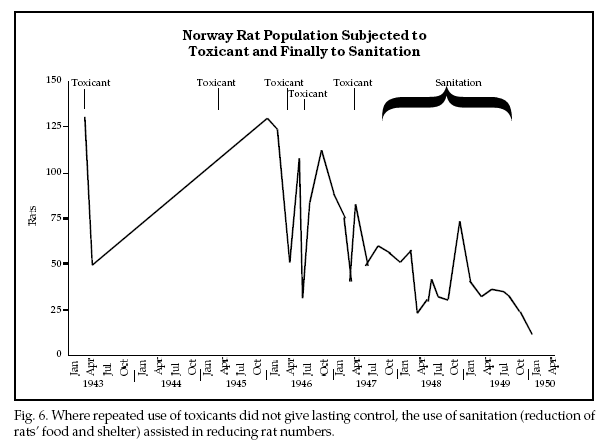
Norway rats are not
protected by law. They may be controlled with any
pesticide registered by federal or state authorities for
this purpose, or they may be controlled by use of
mechanical methods such as traps.
Damage
Prevention and Control Methods
Exclusion
Physical barriers can prevent rats from gaining
entry to structures where food and shelter are
available. “Ratproofing” is an important and often
neglected aspect of rat control. It is a relatively
permanent form of rodent control that prevents damage
from occurring.
To exclude rats, seal all
holes and openings larger than 1/2 inch (1.3 cm) across.
Rodent-proofing should be done with heavy materials that
will resist rodent gnawing. These include concrete
mortar, galvanized sheet metal, and heavy-gauge hardware
cloth.
Habitat
Modification
In addition to the
above-mentioned techniques of excluding rodents from
sources of food and shelter, sanitation can play an
important role in controlling rat populations (Fig. 6).
Poor sanitation is one of the basic reasons for the
continued existence of moderate to high rat populations
in urban and suburban areas. In agricultural
environments, proper sanitation cannot always eliminate
rat populations, but it can often prevent rats from
flourishing in large numbers.
Sanitation involves good
housekeeping, including proper storage and handling of
food materials, feed, and edible garbage. Warehouses,
granaries and grain mills, silos, port facilities, and
similar structures may provide excellent habitat for
rats. Store bulk foods in rodent-proof containers or
rooms. Stack sacked or boxed foods in orderly rows on
pallets in a way that allows thorough inspection for
evidence of rats. In such storage areas, keep stored
materials away from walls. A 12-inch (30-cm) white band
painted on the floor adjacent to the wall will aid in
detecting rodent droppings and other rat sign (Fig. 7).
Sweep floors frequently to permit ready detection of
fresh sign.
Pet foods often are a
source of food for rats in and around homes. Keep all
such materials stored in metal rodent-proof containers.
Feed pets only what they will eat at a single time.
Garbage and rubbish from
homes, restaurants, farms, and other such sources should
be properly stored and subsequently removed for
disposal. A proper refuse storage container is
heavy-duty, rust-resistant, rat- and damage-resistant,
and equipped with a tight-fitting lid. Galvanized steel
trash containers in good condition are better than those
made of vinyl or plastic. Racks or stands prevent
corrosion or rusting of containers, reduce rat shelter
under containers, and minimize the chance of containers
being overturned (Fig. 8).
Bulk storage containers
for refuse, such as those used at apartments,
businesses, and housing projects, should be similarly
rodent-proof. Large metal refuse containers (dumpsters)
sometimes have drain holes to facilitate cleaning. These
drain holes should be fitted with a wire mesh screen or
a removable plug; otherwise, the container becomes a
huge feeding station for rodents (Fig. 9).
Refuse should be collected
regularly and before refuse storage containers become
filled to excess. Sanitary landfills and incinerators
seldom have conditions that will allow rat populations
to exist. On the other hand, open refuse dumps are often
infested by Norway rats. At a properly operated sanitary
landfill, garbage and rubbish are compacted and covered
with earth daily. Modern incinerators completely burn
refuse, and the resulting residue does not provide food
for rats.
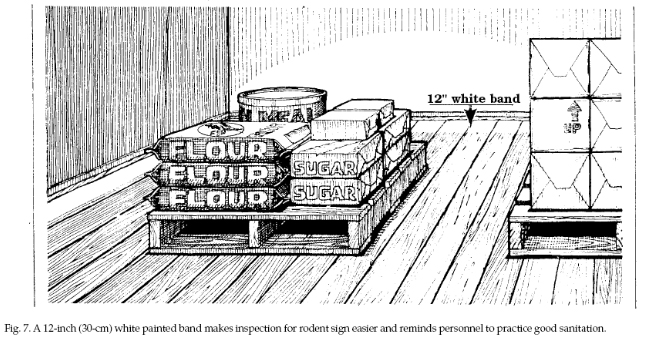
Sewers are inhabited by
Norway rats in some towns and cities. Rats may enter at
outlets and through
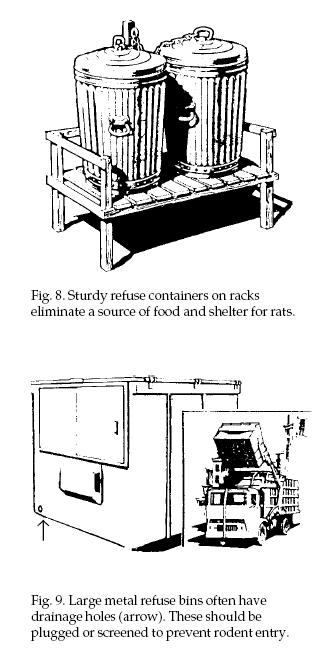 manholes,
catch basins, broken pipes, or drains. Since Norway rats
are excellent swimmers, water traps do not impede their
movement; in fact, they can travel upstream against a
current. The problem of rats in sewers is usually
greatest in places where sanitary sewers are
interconnected with storm sewers, thus providing
multiple entry points for rats. The domestic sewage of
an average community provides enough food to sustain a
large number of rats; this problem has increased as a
result of the recent prevalence of garbage disposal
units in most newer homes. manholes,
catch basins, broken pipes, or drains. Since Norway rats
are excellent swimmers, water traps do not impede their
movement; in fact, they can travel upstream against a
current. The problem of rats in sewers is usually
greatest in places where sanitary sewers are
interconnected with storm sewers, thus providing
multiple entry points for rats. The domestic sewage of
an average community provides enough food to sustain a
large number of rats; this problem has increased as a
result of the recent prevalence of garbage disposal
units in most newer homes.
Regular removal of debris
and control of weeds from around structures will reduce
the amount of shelter available to rats. In some
instances, a strip of heavy gravel placed adjacent to
building foundations or other structures will reduce rat
burrowing at these locations. Gravel should be at least
1 inch (2.5 cm) in diameter and laid in a band at least
2 feet (0.6 m) wide and 1/2 foot (15 cm) deep. In any
event, keep the perimeter of buildings and other
structures clean of weeds and debris (including stacked
lumber, firewood, and other stored materials) to
discourage rat activity and to allow easier detection of
rat sign.
Frightening
Rats are wary animals and
can be frightened easily by unfamiliar sounds or sounds
coming from new locations. Most rodents, however, can
quickly become accustomed to new sounds heard
repeatedly. For years, devices that produce ultrasonic
sound that is claimed to control rodents have come and
gone on the market. There is little evidence to suggest
that rodents’ responses to nonspecific, high-frequency
sound is any different from their response to sound
within the range human of hearing.
What is known about
rodents and sound?
—Unusually loud, novel
sounds, including ultrasonic sounds, which rats can
hear, will frighten them and may cause temporary
avoidance lasting from a few minutes to weeks or months.
What is known about ultrasonic sound? —It is very
directional and does not travel around corners well;
thus, sound shadows or voids are created. —Ultrasound
does not travel very far. It loses its intensity rapidly
as it leaves the source. —Ultrasound has not been shown
to drive established rodents out of buildings or areas,
nor has it been proven to cause above-normal mortality
in their populations. While it is possible to cause
convulsions or permanent physiological damage to rodents
with ultrasound, the intensity of such sounds must be so
great that damage to humans or domestic animals would
also be likely. Commercial ultrasonic pest control
devices do not produce sound of such intensity. Tests of
commercial ultrasonic devices have indicated that rats
may be repelled from the immediate area of the
ultrasound for a few days, but then will return and
resume normal activities. Other tests have shown the
degree of repellency to depend upon the particular
ultrasonic frequencies used, their intensity, and the
preexisting condition of the rodent infestation.
Ultrasonic sound has very limited usefulness in rodent
control. The advertising claims for many commercial
devices are unsubstantiated by scientific research.
Since commercial ultrasonic devices are often expensive
and of questionable effectiveness, they cannot be
recommended as a solution to rodent problems.
Repellents
Rats find some types of
tastes and odors objectionable, but chemical repellents
are seldom a practical solution to rat infestations.
Substances such as moth balls (naphthalene) or household
ammonia, in sufficient concentration, may have at least
temporary effects in keeping rats out of certain
enclosed areas. The above materials, however, are not
registered by the EPA as rat repellents.
Ro-pel® is registered for
use in repelling Norway rats and other rodents from
gnawing on trees, poles, fences, shrubs, garbage, and
other objects. Little information is currently available
on its effectiveness against rats.
Other solutions to rat
problems, including rodent-proof construction and
methods of population reduction, are usually more
permanent and cost-effective.
Toxicants
Rodenticides were formerly
classified into two groups, single-dose (acute)
toxicants and multiple-dose (chronic) rodenticides.
However, the complexity in mode of action of newer
rodenticides makes these classifications outdated. A
classification into two groups, the first including all
anticoagulants, and the second all other compounds
(“non-anticoagulants”), is currently more useful.
Anticoagulants
(slow-acting, chronic toxicants). The anticoagulant
rodenticides have been the most preferred materials for
controlling rats since their initial development
following World War II. They are quite acceptable to
rats, do not cause bait shyness, are easy to apply, and
if used properly, are relatively safe to use around
livestock, pets, and humans.
Rats poisoned with
anticoagulants die from internal bleeding, the result of
loss of the blood’s clotting ability and damage to the
capillaries. Animals killed by anticoagulants may show
extreme lack of color of the skin, muscles, and viscera.
Hemorrhage may be found in any part of the body. Prior
to death, the animal exhibits increasing weakness due to
blood loss.
Several anticoagulant
compounds are registered for controlling Norway rats
(Table 1). With the exception of two (bromadiolone and
brodifacoum), multiple feedings over a period of several
days are usually required to cause death. Relatively
low, chronic doses are fatal, whereas the same amount of
toxicant ingested at a single feeding may produce no
significant effect to the rodent. However, this may vary
for different anticoagulants. Feeding
Table 1. Anticoagulants
used for Norway rat control in the United States.

*Second-generation
anticoagulants especially useful for the control of
warfarin-resistant rats and mice.
does not always have to be
on consecutive days. When anticoagulants are eaten
daily, however, death may occur as early as the third or
fourth day. For optimal lethal effects, several feedings
should occur within a 10-day period with no longer than
48 hours between feedings.
All anticoagulants provide
good to excellent Norway rat control when prepared in
acceptable baits. A new second-generation anticoagulant,
difethialone, is presently being developed and EPA
registration is anticipated in the near future. The
characteristics of the various anticoagulant
rodenticides are described further in the Pesticides
section.
Because of their
similarity in mode of action, all anticoagulant baits
are used in a similar fashion. Label directions commonly
instruct the user to “maintain a continuous supply of
bait for 15 days or until feeding ceases,” thus ensuring
that the entire rat population has ample opportunity to
ingest a lethal dose of the bait. Anticoagulants have
the same effect on nearly all warm-blooded animals, but
the sensitivity to these toxicants varies among species.
If misused, anticoagulant rodenticides can be lethal to
nontarget animals such as dogs, pigs, and cats.
Additionally, residues of anticoagulants which are
present in the bodies of dead or dying rodents can cause
toxic effects to scavengers and predators. In general,
however, the secondary poisoning hazard from
anticoagulants is relatively low.
Brodifacoum and
bromadiolone baits, because of their potential to be
lethal in a single feeding, can be more effective than
the other anticoagulants in certain situations.
Chlorophacinone (RoZol®)
and diphacinone (Ramik®, Ditrac®) are similar in potency
and are more toxic than the anticoagulant compounds
developed earlier. Thus, they are formulated at lower
concentrations. Chlorophacinone and diphacinone may kill
some rats in a single feeding, but multiple feedings are
needed to give adequate control of an entire rat
population.
Pindone (Pival®, Pivalyn®)
is also less potent than chlorophacinone or diphacinone,
and it is regarded as slightly less effective than
warfarin against Norway rats. It has some properties
that resist insects and growth of mold in prepared
baits.
Warfarin (Final® and other
trade names) was the first marketed anticoagulant and
therefore became the best known and most widely used. It
is effective against Norway rats, although some products
may contain small quantities of contaminants that
apparently can reduce bait acceptance. This problem was
resolved by the development of micro-encapsulated
warfarin.
Anticoagulant Resistance.
Within any population of Norway rats, some individuals
are less sensitive to anticoagulants than others. Where
anticoagulants have been used over long periods of time
at a particular location, there is an increased
potential for the existence of a population that is
somewhat resistant to the lethal effects of the baits.
Such resistant populations of rats have been identified
at a number of locations throughout the United States.
Although not common, resistance may be underestimated
because documentation of resistance is usually not
pursued by persons involved in operational rat control
programs.
Resistance, if and when it
occurs, is of little consequence in the control of
Norway rats, especially with the newer rodenticides
presently available. When anticoagulant resistance to
the first-generation anticoagulants is known or
suspected, use of these compounds should be avoided in
favor of the second-generation anticoagulants or one of
the non-anticoagulant products.
Anticoagulant Bait
Failure. Resistance is only one (and perhaps the least
likely) reason for failure in the control of rats with
anticoagulant baits. Control with baits that are highly
accepted may fail for one or more of the following
reasons:
—Too short a period of
bait exposure.
—Insufficient bait and
insufficient replenishment of bait (none remains from
one baiting to the next). —Too few bait stations and/or
too far apart. In some situations, stations may have to
be within 20 to 30 feet (7 to 10 m) of one another. —Too
small a control area, permitting rats to move in from
untreated adjacent areas. —Genetic resistance to the
anticoagulant. Although this is unlikely, it should be
suspected if about the same amount of bait is taken
daily for a number of weeks. Control with anticoagulant
baits that are poorly accepted may fail for one or more
of the following reasons: —Poor bait choice, or bait is
formulated improperly. Other foods are more attractive
to the rats. —Improperly placed bait stations. Other
foods are more convenient to the rats. —Abundance of
other food choices. —Tainted bait: the bait has become
moldy, rancid, insect-infested, or contaminated with
other material that reduces acceptance. Discard old bait
periodically, and replace it with fresh bait.
Occasionally, rats accept bait well and an initial
population reduction is successful. Then bait acceptance
appears to stop although some rats remain. In such
instances it is likely that the remaining rats never
accepted the bait either because of its formulation or
placement. The best strategy is then to switch to a
different bait formulation, place baits at different
locations, and/ or use other control methods such as
traps.
Other Rodenticides. The
older rodenticides, formerly referred to as acute
toxicants, such as ANTU, arsenic trioxide, phosphorus,
and Compound 1080, are no longer registered for rat
control. The widespread availability of ready-to-use
anticoagulants and their relative effectiveness have
resulted in the reduced use of these older materials
over the last 20 years.

At present, four
non-anticoagulant rodenticides (Table 2) are registered
by EPA against Norway rats: bromethalin, cholecalciferol
(vitamin D3), red squill, and zinc phosphide. All are
potentially useful for controlling
anti-coagulant-resistant populations of rats.
Of these active
ingredients, bromethalin and cholecalciferol are
formulated to serve as chronic rodenticides, applied so
that rats will have the opportunity to feed on the baits
one or more times over the period of one to several
days. Bait acceptance is generally good when
formulations appropriate for rats are selected. Zinc
phosphide and red squill differ in that prebaiting
(offering rats similar but nontoxic bait prior to
applying the toxicant-treated bait) is recommended to
increase bait acceptance. These two rodenticides are not
designed to be left available to rats for more than a
few days, as continued exposure is likely to result in
bait shyness within the population. Be sure to follow
label recommendations on any specific product to achieve
best success.
Non-anticoagulant
rodenticides, particularly zinc phosphide, remain useful
tools to achieve quick reductions in rat populations.
When rat numbers are large, the cost of baiting with
these materials may be lower than for the
anticoagulants.
Bromethalin (Assault®,
Vengeance®) is formulated in a ready-to-use bait as a
chronic rodenticide, applied so that rats will have the
opportunity to feed on the bait one or more times over a
period of one to several days. Because it is a
slow-acting in comparison to zinc phosphide or red
squill, bait shyness is not usually a problem, nor is
prebaiting necessary to get good control in most
situations.
Cholecalciferol (vitamin
D3, Quintox®) is similarly formulated in a ready-to-use
bait, serving as a chronic rodenticide. Death occurs 3
or 4 days after ingestion of a lethal dose. Because the
toxicant is slow-acting, bait shyness is not reported to
occur. It is claimed that rodents cease feeding once a
lethal dose has been ingested.
Red squill is a relatively
selective and safe toxicant for use only against Norway
rats. It acts as an emetic, which provides some degree
of protection to certain nontarget species that might
accidentally consume the bait. Rats, which cannot vomit,
are unable to rid themselves of the toxicant once it is
consumed. In the past, one problem was the variation in
the quality of the material, which is derived from a
plant. Red squill must be stored in a sealed container,
as moisture will cause loss of potency.
Zinc phosphide is a dark
gray powder, insoluble in water, that has been used
extensively in the control of rodents. It is available
in ready-to-use dry baits and also in concentrates for
use by persons trained in rodent control who may wish to
prepare their own baits. Its strong garlic-like odor
appears to be attractive to rodents that are not
bait-shy. Oils and fats make excellent binders for zinc
phosphide and increase absorption of the toxicant when
ingested. An effective bait is made from mixing zinc
phosphide with meat such as canned fish-flavored cat
food. Rats will readily accept this bait, especially if
adequate prebaiting has been done beforehand.
The following general
steps are recommended to obtain good bait acceptance,
and therefore good rat control, when using zinc
phosphide baits:
-
Prebait rats for a
minimum of 3 to 5 days to get the rats accustomed to
eating the nontoxic bait material. Do not change
types of bait during the prebaiting or baiting
operation. Apply prebait at many locations, wherever
there is rat activity. Where bait is completely
eaten overnight, double the amount of prebait at
that location the next day. Repeat this procedure
until the amount of bait eaten every night no longer
increases.
-
Use only high-quality
grains and fresh ready-to-use baits. Where rats have
access to abundant amounts of grain, meat such as
canned fish-flavored cat food may be a good
substitute. Obtain a sufficient quantity to complete
the project without changing brands or flavors.
-
Wait until prebait
consumption has peaked before applying toxic baits.
Remove any uneaten prebait and place the toxic bait
at the same locations that the prebait was applied.
Usually, the amount of toxic bait needed will be
about half the amount used on the last day that
prebait was applied. It may be helpful to wait one
day between the last application of prebait and
application of toxic bait. That way, rats will be
hungrier. Mix the toxicant into the bait ingredients
according to label directions, if preparing your own
baits from a concentrate.
-
Avoid handling the
toxic bait or rodenticide concentrate with bare
hands; use rubber or latex gloves. Clean thoroughly
any tools or containers used in bait mixing, or
safely dispose of them as well as bait packaging
materials.
-
Confine or restrain
any pets, livestock, or other animals that may
otherwise gain access to and feed on the bait. It
may also be necessary to place prebait and toxic
bait into bait boxes for safety.
-
Following toxic bait
application, pick up and dispose of available dead
rats and all uneaten bait by incineration or deep
burial. Normally, bait should be exposed for only 1
or 2 nights; the greatest consumption occurs on the
first night.
-
Control remaining rats
by using anticoagulant baits or by using traps or
burrow fumigants.
Bait Selection and
Formulation
Contrary to popular
belief, rats prefer fresh, high-quality foods and will
reject spoiled or inferior foods item when given a
choice. Therefore, rodent baits should be made from
high-quality food materials.
Usually corn, oats, wheat,
or barley are the grains most preferred by Norway rats.
Preference will vary between rat populations and among
individual rats. Baits similar to foods rats are
accustomed to eating are often a good choice,
particularly if their normal foods are limited or can be
made less available to them. Some people trained in
rodent control prefer to mix their own baits. Ground
cereal grains are often mixed with 5% powdered sugar and
3% to 10% vegetable oil. A toxicant concentrate is added
to this mixture in the proper amount. Certain
anticoagulants, as well as zinc phosphide, can be
purchased in concentrate forms for use in formulating
baits. Under some conditions, baits made with fruits,
vegetables, meat, or fish may be highly accepted. Use of
such bait materials, however, may increase the risk of
poisoning cats, dogs, domestic animals, and other
nontarget species.
To determine bait
preference in rats, conduct a bait-choice test by
placing about 4 ounces (115 g) of each of several
nontoxic baits about one foot (30 cm) apart in several
locations where rats are present. Check baits for the
next few days to find out which foods rats preferred.
Keep in mind that rats are suspicious of new objects and
novel foods; therefore, they may not accept a new bait
until the third or fourth day.
The ready-to-use baits
most available to the public are anticoagulant
rodenticides. Several types are available. Grain-based
baits in a loose meal or pelleted form are available in
bulk or packaged in small, 4- to 16-ounce (112to 454-g)
plastic, cellophane, or paper “place packs” (Fig. 10).
These packets keep bait fresh and make it easy to place
baits into burrows, walls, or other locations. Rats will
gnaw into these bags to feed on acceptable baits.
Pelleted baits can more easily be carried by rats to
other locations. Such hoarding of food by rats is not
uncommon. It may result in amounts of bait being moved
to places where it is undetected or difficult to recover
and may, if accessible, be hazardous to nontarget
species.
 Anticoagulant
baits have also been formulated into wax and extruded
blocks (Fig. 11). These are particularly useful in
sewers or where moisture may cause loose grain baits to
spoil. Rats accept paraffin block baits less readily
than loose or pelleted grain baits, but acceptance of
extruded bait blocks is high. Anticoagulant
baits have also been formulated into wax and extruded
blocks (Fig. 11). These are particularly useful in
sewers or where moisture may cause loose grain baits to
spoil. Rats accept paraffin block baits less readily
than loose or pelleted grain baits, but acceptance of
extruded bait blocks is high.
Sodium salts of
anticoagulants are available as concentrates to be mixed
with water, making a liquid bait (Fig. 12). Since rats
require water daily, they can be drawn to water stations
where other water sources are scarce. Water baits are
particularly useful in grain storage structures,
warehouses, and other such locations. Rodents are more
easily able to detect anticoagulants in water baits than
in food baits; therefore, up to 5% sugar is sometimes
added to liquid baits to increase rats’ acceptance of
the bait solution. Since water is attractive to most
animals, use water baits in ways that prevent nontarget
animals from drinking them.
Bait Stations
Bait stations (bait boxes)
may increase both the effectiveness and safety of
rodenticides. They came into general use after the
development of the first-generation anticoagulants,
which require that a continuous supply of bait be made
available to rodents. Bait stations are useful because
they:
—protect bait from
moisture and dust; —provide a protected place for
rodents to feed, allowing them to feel more secure;
—keep other animals (pets, livestock, desirable
wildlife) and children away from hazardous bait; —allow
placement of bait in locations where it would otherwise
be difficult because of weather or potential hazards to
nontarget animals; —help prevent the accidental spilling
of bait; —allow easy inspection of bait to see if
rodents are feeding on it.
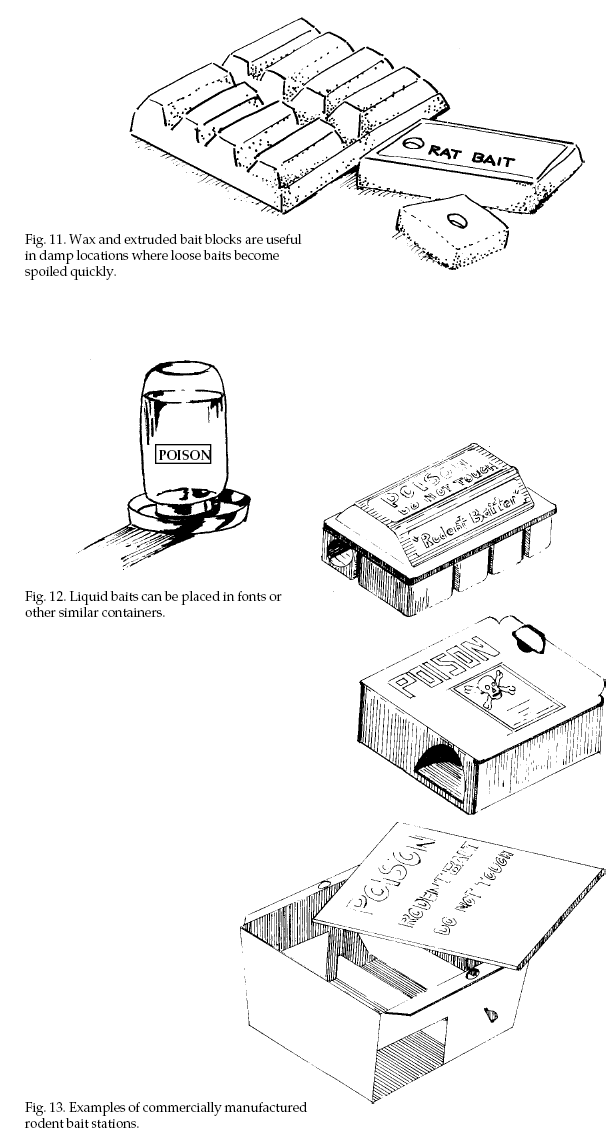
Kinds of Bait Stations.
Bait stations can contain solid baits liquid baits, or
both. Bait boxes can be purchased from commercial
suppliers or made at home. Manufactured bait boxes made
of plastic, cardboard, or metal (Fig. 13) are sold to
pest control companies and to the public in sizes for
rats or mice. Some farm supply and agricultural chemical
supply stores have them in stock or can order them.
Bait boxes can be built
from scrap materials, and homemade stations can be
deigned to fit individual needs. Make them out of sturdy
materials so they cannot be easily knocked out of place
or damaged. Where children, pets, or livestock are
present, be careful to construct the stations so that
the bait is accessible only to rodents. Locks, seals, or
concealed latches are often used to make bait boxes more
tamperproof. In some situations, stations should be
secured in place. Clearly label all bait boxes or
stations with “Poison” or “Rodent Bait — Do Not Touch,”
or with a similar warning. Some rodenticides or
situations may require use of tamper-resistant bait
stations. If so, use only bait boxes or stations which
are so designated, and also be sure to secure them to
buildings by nailing or gluing them to walls or floors
in a way that will not permit a person or animal to
knock them over or shake the bait out.
Bait Station Design. Bait
stations should be large enough to allow several rodents
to feed at once. They can be as simple as a flat board
nailed at an angle to the bottom of a wall (Fig. 14), or
a length of pipe into which bait can be placed (Fig.
15). More elaborate stations are completely enclosed and
can contain liquid as well as solid baits (Fig. 16). A
hinged lid with a childproof latch can be used for
convenience in inspecting permanent stations.
Bait stations for rats
should have at least two openings approximately 2 1/2
inches (6 cm) in diameter. The two holes should be on
opposite sides of the station because rodents can see an
alternate escape route as they enter the station.
Bait Station Maintenance.
Baits must be fresh and of high quality. Rats will
reject spoiled or stale foods. Provide enough fresh bait
to allow rodents to eat all they want. When you first
put bait boxes out, check them daily and add fresh bait
as needed. After a short time, rodent numbers and
feeding will decline, and you will need to check the
boxes only every 2 weeks or once a month. If the bait
becomes moldy, musty, soiled, or insect-in-fested, empty
the box and clean it, and then refill it with fresh
bait. Dispose of spoiled or uneaten bait in accordance
with the label. Follow all label directions for the
product you are using.
Placement of Bait
Stations.
Proper placement of bait
stations is just as important as bait selection. Rats
will not visit bait stations, regardless of their
contents, if they are not conveniently located in areas
where rodents are active.
Where possible, place bait
between the rodents’ source of shelter and their food
supply. Put bait boxes near rodent burrows, against
walls, or along travel routes. Since rats are often
suspicious of new or unfamiliar objects, it may take
several days for them to enter and feed in bait
stations.

On farmsteads, bait
station placement depends on building design and use. In
swine confinement buildings, it may be possible to
attach bait boxes to wall ledges or the top of pen
dividing walls. Bait boxes may be placed in attics or
along the floors or alleys where rodents are active
(Fig. 17). Rodent tracks visible on dusty surfaces and
their droppings often give clues to where they are
active.
Never place bait stations
where livestock, pets, or other animals can knock them
over. Spilled bait may be a potential hazard,
particularly to smaller animals.
Where buildings are not
rodent-proof, permanent bait stations can be placed
inside buildings, along the outside of building
foundations, or around the perimeter. Bait stations will
help keep rodent numbers at a low level when maintained
regularly with fresh anticoagulant bait. Rodents moving
in from nearby areas will be controlled before they can
reproduce and cause serious damage.
Tracking Powders. Toxic
dusts or powders have been successfully used for many
years to control rats and mice. When rodents walk
through a patch of toxic powder, they pick some of it up
on their feet and fur and later ingest it while
grooming. Tracking powders are useful in controlling
rats where food is plentiful and good bait acceptance is
difficult to achieve. Rats are more likely to ingest a
lethal amount of a poorly accepted toxicant applied by
this method than if it is mixed into a bait material.
There is little likelihood of toxicant shyness
developing when using tracking powders.
Because the amount of
material a rat may ingest while grooming is small, the
concentration of active ingredient in tracking powders
is considerably higher than in food baits that utilize
the same toxicant. Therefore, these materials can be
more hazardous than food baits. For the most part,
tracking powders are used by professional pest control
operators and others trained in rodent control.
Currently, the only tracking powders registered for use
against Norway rats contain anticoagulants.
Place tracking powders in
rat burrows, along runways, in walls, behind boards
along walls, or on the floor of bait stations. Placement
can be aided by using various types of sifters, shakers,
or blowers. Dampness may cause the powder to cake and
lessen its effectiveness. Care must be taken to place
tracking powders only where they cannot contaminate food
or animal feed, or where nontarget animals cannot come
into contact with them. Do not place tracking powders
where rats can track the material onto food intended for
use by humans or domestic animals. Tracking powders are
not generally recommended for use in and around homes
because of potential hazards to children and pets. Where
possible, remove tracking powder after the rodent
control program is completed.
Fumigants
Fumigants (toxic gases)
are most commonly used to control rats in their burrows
at outdoor locations. Compounds including aluminum
phosphide, chloropicrin, and gas cartridges, are
registered for this purpose. The incendiary gas
cartridge burns, producing carbon monoxide and other
gases that suffocate rodents in their burrows. Methyl
bromide is presently registered only for fumigation of
structures by qualified professionals. Anhydrous ammonia
is not recommended for use as a burrow fumigant because
it is not registered for this purpose. For further
information on fumigants, see the Pesticides section.
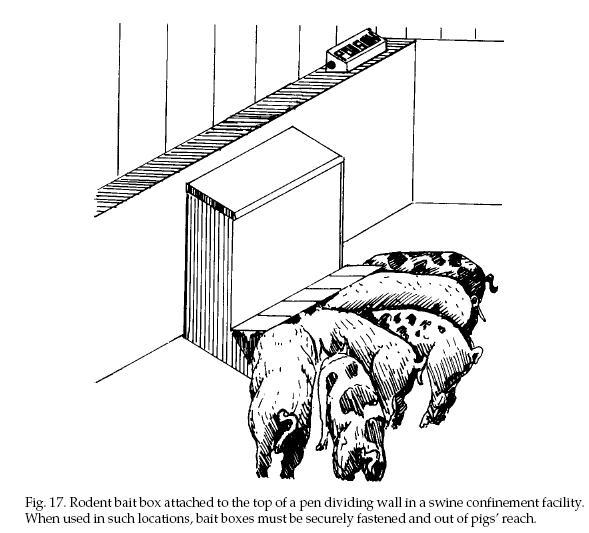
Fumigants should only be
used by people familiar with the necessary precautions
because they are highly toxic to humans and other
animals. Do not use fumigants in any situation that
might expose the occupants of a building to the fumes.
Only licensed structural pest control operators should
use fumigants in buildings or other structures.
To fumigate rat burrows,
close the burrow opening with soil or sod immediately
after introduction of the fumigant. Rat burrows often
have multiple entrances, and all openings must be sealed
in order for fumigants to be effective. Fumigants are
less effective in soils that are very porous or dry.
Trapping
Trapping can be an
effective method of controlling rats, but it requires
more skill and labor than most other methods. Trapping
is recommended where toxicants are inadvisable. It is
the preferred method to try first in homes, garages, and
other small structures where there may be only a few
rats present.
Trapping has several
advantages: (1) it does not rely on inherently hazardous
rodenticides; (2) it permits the user to view his or her
success; and (3) it allows for disposal of the rat
carcasses, thereby eliminating odor problems from
decomposing carcasses that may remain when poisoning is
done within buildings.
The simple, inexpensive,
wood-based snap trap is available in most hardware and
farm supply stores. Traps should be baited with a small
piece of hot dog, bacon, or nutmeat tied securely to the
trigger. Peanut butter or marshmallows also may be used
as bait. Baits that become stale lose their
effectiveness.
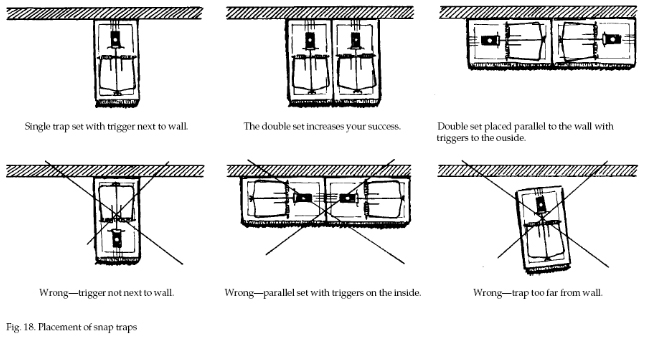
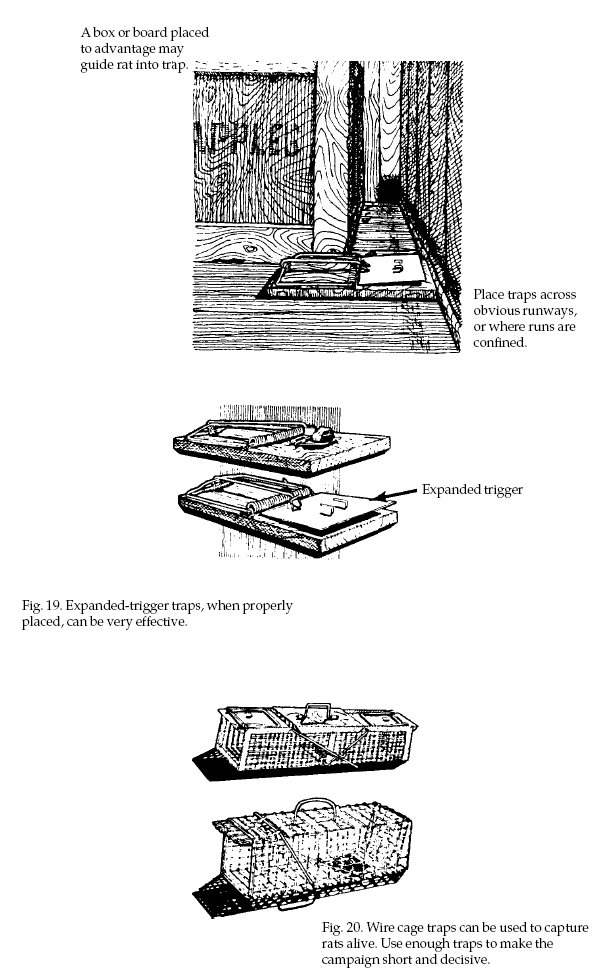
Set traps close to walls,
behind objects, in dark corners, and in places where rat
activity is seen. Place the traps so that when rats
follow their natural course of travel (usually close to
a wall) they will pass directly over the trigger (Fig.
18). Set traps so that the trigger is sensitive and will
spring easily. Effectiveness can be increased by
enlarging the trigger. Attach a square of cardboard,
metal, or screen wire that fits just inside the wire
deadfall (Fig. 19).
Leaving traps unset until
the bait has been taken at least once reduces the chance
of rats escaping the trap and becoming trap-shy. Other
kinds of traps are also effective in catching rats.
Wire-mesh cage traps such as the National®, Tomahawk®,
and Havahart® can be used effectively to capture rats
alive (Fig. 20). Wire fun-nel-entrance traps have also
been used to capture rats alive.
Keep traps reasonably
clean and in good working condition. They can be cleaned
with a hot detergent solution and a stiff brush. Human
and dead-rat odors on traps are not known to reduce
trapping success.
An alternative to traps
are glue boards, which catch and hold rats attempting to
cross them, much the same way flypaper catches flies.
Place glue boards wherever rats travel — along walls or
in established runways. Do not use glue boards where
children, pets, or desirable wildlife can contact them.
Glue boards lose their effectiveness in dusty areas
unless covered, and temperature extremes may affect the
tackiness of some glues. They are considered less
effective for capturing rats than for mice. Glue boards
can be purchased ready-to-use or they can be made.
Euthanize live, trapped rodents by asphyxiation with
carbon dioxide, or use a stick to kill them with sharp
blows to the base of the skull. For further information
on glue boards, see the Supplies and Materials section.
Other Methods
In some situations, rats
can be killed manually with a club or other implement.
When rats have access to a structure through only one or
a few entrances, it may be possible to drive them out en
masse. Then they can be clubbed or shot with a pellet
gun or .22 firearm loaded with birdshot.
Some dogs and cats will
catch and kill rats. There are few situations, however,
in which they will do so sufficiently to control rat
populations. Around most structures, rats can find many
places to hide and rear their young out of the reach of
such predators. Cats probably cannot eliminate existing
rat populations, but in some situations they may be able
to prevent reinfestations once rats have been
controlled. Farm cats, if sufficient in number and
supplementally fed, may serve this function.
In urban and suburban
areas, rats may be present because people have pets. It
is not uncommon to find rats living in close association
with cats and dogs, relying on cat and dog food for
nourishment. Rats frequently live beneath dog houses and
soon learn they can feed when the dog is absent or
asleep.
Economics of Damage and Control
Accurate data on rat
damage, control, and their cost is difficult to obtain.
Estimates of losses of foodstuffs, structural damage,
and the amount of labor and materials expended to
control rats are usually only educated guesses. One
study found that a small colony of Norway rats (10 to 26
animals), when given access to a ton of sacked wheat,
would contaminate 70% of the grain after 12 to 28 weeks.
The sacks were heavily damaged as well. Total damage
equaled 18.2% of the total value of the wheat and the
sacks.
One rat will eat
approximately 20 to 40 pounds (9 to 18 kg) of feed per
year and probably contaminates 10 times that amount with
its urine and droppings. In a year’s time, a single rat
will produce some 25,000 droppings. A 1973 estimate
states rats may cost the United States between $500
million and $1 billion annually in direct economic
losses. In most cases, the cost of rat
control—particularly when it is done in a timely
fashion—is far less than the economic loss caused by rat
damage.
Acknowledgments
I thank Rex E. Marsh for
reviewing this chapter and providing many helpful
comments. The material it contains includes information
taken from Brooks 1973, Howard and Marsh 1981, and Pratt
et al. 1977, among other sources.
Figures 1 and 3 from
Schwartz and Schwartz (1981) adapted by Jill Sack
Johnson.
Figures 2, 4, 6, 7, 8, 9,
19 and 20 adapted from Pratt et al. (1977) by Jill Sack
Johnson.
Figures 5 and 18 adapted
from Howard and Marsh (1981) by Jill Sack Johnson.
Figures 10, 11 and 12 by
Jill Sack Johnson.
Figures 13, 16 and 17 by
Frances I. Gould.
Figures 14 and 15 adapted
from Pratt et al., (1977) by Frances I. Gould.
For Additional Information
Brooks, J. E. 1973. A
review of commensal rodents and their control. CRC
Critical Reviews in Environ. Control. 3(4):405-453.
Brown, R. Z. 1969.
Biological factors in domestic rodent control. Public
Health Service, US Dep. Health, Educ. Welfare, Bull. No.
773. 32 pp.
Calhoun, J. B. 1962. The
ecology and sociobiology of the Norway rat. Public
Health Serv., US Dep. Health, Educ. Welfare, Pub. No.
1008, 288 pp.
Chitty, D., and H. N.
Southern. 1954. Control of rats and mice. Vol. 1-3.
Clarendon Press, Oxford, U.K.
Davis, D. E. 1981.
Environmental control of rodents. Pages 493-498 in D.
Pimentel, ed. CRC Handbook of pest management in
agriculture, Vol. 1. CRC Press, Inc., Boca Raton,
Florida.
Elton, C. S. 1953. The use
of cats in farm rat control. British J. An. Behav.
1:151.
Emlen, J. T., Jr., A. W.
Stokes, and D. E. Davis. 1949. Methods for estimating
populations of brown rats in urban habitats. Ecology
30:430-442.
Emlen, J. T., Jr., A. W.
Stokes, and C. P. Winsor. 1948. The rate of recovery of
decimated populations of brown rats in nature. Ecology
29:133-145.
Fitzwater, W. D. 1982.
Bird limes and rat glues — sticky situations. Proc.
Vertebr. Pest Conf. 10:17-20.
Frantz, S. C. 1976. Rats
in the granary. Nat. Hist. 85(2):10-21.
Frantz, S. C., and D. E.
Davis. 1991. Bionomics and integrated pest management of
commensal rodents. Pages 243-313 in J. R. Gorham, ed.
Ecology and management of food-industry pests FDA tech.
Bull. 4, Assoc. Official Analytical Chem. Arlington,
Virginia.
Greaves, J. H. 1976. Loss
determination by population assessment and estimation
procedures. Pages 109-115 in K. L. Harris and C. J.
Lindblad, eds. Postharvest grain loss assessment
methods. Am. Assoc. Cereal Chem.
Gutteridge, N. J. A. 1972.
Chemicals in rodent control. Chem. Soc. Rev. 1:381-409.
Howard, W. E., and R. E.
Marsh. 1981. The rat: its biology and control. Univ.
California Div. Agric. Sci. Pub. No. 2896. 30 pp.
Huson, L. W., and B. D.
Rennison. 1981. Seasonal variability of Norway rat (Rattus
norvegicus) infestation of agricultural premises. J.
Zool. 194:257-260.
Jackson, W. B. 1982.
Norway rat and allies. Pages 1077-1088 in J. A. Chapman
and G. A. Feldhamer, eds. Wild mammals of North America:
biology, management, and economics. The Johns Hopkins
University Press, Baltimore, Maryland.
Jackson, W. B. 1990. Rats
and mice. Pages 9-85 in A. Mallis, ed. Handbook of pest
control. Franzak and Foster Co., Cleveland, Ohio.
Jackson, W. B., and M.
Temme. 1976. General considerations, direct measurement
techniques, and biological aspects of survey procedures.
Pages 101-107 in K. L. Harris and C. J. Lindblad, eds.
Postharvest grain loss assessment methods Am. Assoc.
Cereal Chem.
Jackson, W. B., S. R.
Spaulding, R. B. L. Van Lier, and B. A. Dreikorn. 1982.
Bromethalin — a promising new rodenticide. Proc. Vertebr.
Pest Conf. 10:10-16.
Kaukeinen, D. E. 1982. A
review of the secondary poisoning hazard potential to
wildlife from the use of anticoagulant rodenticides.
Proc. Vertebr. Pest Conf. 10:151-158.
Kaukeinen, D. E. 1984.
Resistance: what we need to know. Pest Manage.
3(3):26-30.
Meehan, A. P. 1984. Rats
and mice: their biology and control. Rentokil Ltd., E.
Grinstead, U.K. 383 pp.
Pratt, H. D., B. F.
Bjornson, and K. S. Littig. 1977. Control of domestic
rats and mice. Public Health Serv. US Dep. Health, Educ.
Welfare, Pub. No. (CDC) 77-841. 47 pp.
Pratt, H. D., and R. Z.
Brown. 1976. Biological factors in domestic rodent
control. Public Health Serv., US Dep. Health, Educ.
Welfare, Pub. No. (CDC) 77-8144. 30 pp.
Rennison, B. D. 1977.
Methods of testing rodenticides in the field against
rats. Pesticide Sci. 8:405-413.
Robbins, R. J. 1980.
Taste-aversion learning and its implications for rodent
control. Proc. Vertebr. Pest Conf. 9:114-121.
Salmon, T. P., and R. E.
Marsh. 1979. Age as a factor in rodent susceptibility to
rodenticides - a review. Pages 84-98 in J. R. Beck, ed.
Vertebrate pest control and management materials, ASTM
STP 680. Am. Soc. Testing Materials, Philadelphia. 323
pp.
Schwartz, C. W., and E. R.
Schwartz. 1981. The wild mammals of Missouri, rev. ed.
Univ. Missouri Press, Columbia. 356 pp.
Twigg, G. 1975. The brown
rat. David and Charles, London. 150 pp.
US Department of the
Interior. 1959. Characteristics of common rodenticides.
US Fish Wildl. Serv. Wildl. Leaflet 337. 4 pp.
Weber, W.J. 1982. Diseases
transmitted by rats and mice. Thomson Pub. Fresno,
California. 182 pp.
Editors
Scott E. Hygnstrom, Robert
M. Timm, Gary E. Larson
PREVENTION AND CONTROL OF
WILDLIFE DAMAGE — 1994
Cooperative Extension
Division Institute of Agriculture and Natural Resources
University of Nebraska -Lincoln
United States Department
of Agriculture Animal and Plant Health Inspection
Service Animal Damage Control B-105
Great Plains Agricultural
Council Wildlife Committee
03/09/2007
Special
thanks to:
Clemson University
|